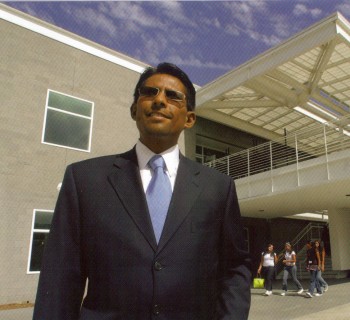By Stephen Wall, The Press-Enterprise, Sept. 5, 2016
Hilliary Salley was teaching kindergarten students how to form sentences when a shy 5-year-old approached her with a question in Spanish.
“Espera un momento,” Salley replied, telling the girl to wait a minute while she helped another child.
Those three words were the only time Salley used Español while instructing English learners during a recent 30-minute lesson at West Riverside Elementary School in Jurupa Valley.
It was no accident that few Spanish words are heard in classrooms.
The passage of Prop. 227 in 1998 required English-only classrooms in California. Since then, students who don’t speak English have received little help in Spanish or other native tongues unless parents asked for it.
Some say the approach has failed. English learners, who comprise about one in five students in California and the Inland area, lag behind other groups based on test scores and other data, the measure’s critics say.
The year before voters passed Prop. 227, about 30 percent of the state’s English learners were in programs that used their native language. A decade later, the number fell to 5 percent.
“Over the years, we have really seen the impact negatively on English learners,” said Jan Gustafson-Corea, CEO of the California Association for Bilingual Education. “Although we have pockets of strong programs, the English-only approach has not worked successfully for students and hasn’t given educators the tools and resources to meet their needs.”
Gustafson-Corea’s group backs a new ballot measure that would remove the restrictions set by Prop. 227. Prop. 58 on the Nov. 8 ballot, would eliminate the state’s requirement that English learners be taught only in English.
The proposal would allow schools to greatly expand the use of Spanish and other languages. Parents would no longer have to sign waivers to put their kids into bilingual or dual immersion programs that teach them in English and Spanish.
SOME THINK IT’S A BAD IDEA
“I’m horrified by this whole thing,” said Ken Noonan, a former superintendent of the Oceanside Unified School District who switched sides on the issue. “I can’t imagine people would want to do it.”
Noonan was a bilingual teacher and directed an English learner program in the Pomona Unified School District before becoming superintendent in Oceanside from 1997 to 2007.
He opposed Prop. 227, but changed his mind after it passed and he saw how the English-only approach worked in a second-grade classroom. He asked a Latino boy whose first language was Spanish questions about a book he read in English. The child answered perfectly. The same thing happened with many other kids, he said.
Within four years after the initiative passed, English learners’ reading scores soared on state tests, California Department of Education data show.
“I believed this was the wrong way to go,” Noonan said. “It turned out to be extremely effective.”
GLOBAL ADVANTAGES
Bilingual education advocates argue children who speak one language are being left behind in a global economy.
A June report from The Civil Rights Project at UCLA concluded that bilingual workers outside the United States are winning the battle for jobs over people in the country who speak one language.
The children of immigrants who lost their skills in Spanish and other languages saw their earnings drop by $5,000 a year because of foreign competition, the report said.
“California is the world’s sixth-largest economy and our kids will compete with kids from China, India and Europe,” said state Sen. Ricardo Lara, D-Bell Gardens, who wrote the bill on which Prop. 58 is based. “We know that in those economies, their children are graduating from elementary school already being multilingual.”
Lara said the measure would encourage students to keep their native language and learn English as quickly as possible. The proposal allows schools to craft their own English learner programs. They would have to offer English-only classes if enough parents want them.
Supporters point to data that show most students in English-only classes are struggling. More than 60 percent of the state’s English learners in grades 6 to 12 have been in the program six or more years despite being immersed in the English language, state education department data show.

Kindergartner Kevin De La Rosa, left, tries to answer a question in his class at West Riverside Elementary School in Jurupa Valley on Wednesday, August 31, 2016. Eighteen years after California voters mandated English immersion in public schools, a November proposition would overturn Prop. 227 and expand multilingual programs. The issue plays out amid a heated presidential campaign in which immigration is a major concern of voters. We talk to Inland educators, parents and others on both sides about whether bilingual education helps or hurts students in our increasingly diverse region. STAN LIM/STAFF PHOTOGRAPHER
FACING CHALLENGES
Children need to gain listening, speaking, reading and writing skills in their first language so they can learn English successfully, said Lilian Jezik, supervisor of teacher education and coordinator of English learners at UC Riverside Extension.
“Many English learners face more challenges in an English-only program and need more support in order to be successful,” Jezik said. “Unfortunately, it just doesn’t happen as often as we would like it to.”
Silicon Valley software entrepreneur Ron Unz, author of Prop. 227, said that if Prop. 58 passes, it will open the door to a new era of bilingual education that will lead to a parent “revolt.”
“The war’s been over for, like, 15 years,” he said. “If parents want bilingual programs, they can ask for a waiver now. But it’s hard to persuade them to sign it because they don’t want it.”
Lara said there’s so much red tape and paperwork involved in the waiver process that parents are discouraged from seeking them.
Noonan, the former Oceanside superintendent, said Latino students are graduating from high school and finishing college in higher numbers since Prop. 227 passed. He attributed the trend to the English-only system.
“English is the language of this nation,” Noonan said. “It’s our obligation to teach that, not to teach the home language if it’s other than English.”
Some Inland school districts have embraced Prop. 58. For example, San Bernardino City Unified School District trustees passed a resolution supporting the measure in August.
The proposal is in line with the district’s multilingual initiative, which the board approved last year and includes efforts to expand foreign language classes in middle school and possibly add Mandarin Chinese, Farsi and other languages in high school. The district hopes to grow its popular dual immersion programs in English and Spanish, said Ana Applegate, director of English learner programs.
“There’s always been a little bit of stigma because of Prop. 227,” she said. “I think a lot more people will want their children in those programs if Prop. 58 passes. Word is going to get out that other languages are a valuable resource to have.”
Jesús Holguín, president of the Moreno Valley Unified School District board, backs the new measure and plans to ask his board to support a resolution supporting Prop. 58.
He predicts students will do better if it becomes law.
“We have all these Spanish speakers who are falling behind who don’t get it because of the language, not because they can’t understand the topic,” Holguín said. “This will move them into the mainstream faster.”
In Salley’s West Riverside classroom, she worked with a small group of English learners to find the main idea in the story, “Pete The Cat.” She asked questions to help them answer orally and write complete sentences.
Salley and co-teacher Latressa McCullough didn’t want to talk about Prop. 58. They said what they’re doing is working, though there’s always room for improvement.
“I think it’s very effective,” McCullough said. “By the middle of the year, they pick (English) up and it’s academic. It’s the English they need to be successful in school.”







